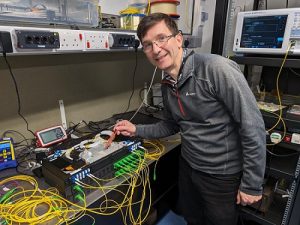You are invited to select the research project from the last year that you feel will make the largest impact on the commercial market in the next five years. The six universities involved are (alphabetically): Aston, Bath, Glasgow, Leicester, Nottingham Trent and Oxford.
As in previous years, the Electronics Weekly editorial team has selected the shortlist of entrants. And we do ask you to look at all the entrants below before voting.
402Tbit/s down commercial optical fibre
 A team at Aston University sent data at a rate of 402 terabits per second, which is a world record. They were using “standard fibre” for the optical comms. Normally, just one or two bands are used in fibre optical communication. However, the Aston Institute of Photonic Technologies (AIPT) academics were using six. “This finding could help increase capacity on a single fibre so the world would have a higher performing system,” said Aston University’s Dr Ian Philips. “The newly developed technology is expected to make a significant contribution to expand the communication capacity of the optical communication infrastructure as future data services rapidly increase demand.”
A team at Aston University sent data at a rate of 402 terabits per second, which is a world record. They were using “standard fibre” for the optical comms. Normally, just one or two bands are used in fibre optical communication. However, the Aston Institute of Photonic Technologies (AIPT) academics were using six. “This finding could help increase capacity on a single fibre so the world would have a higher performing system,” said Aston University’s Dr Ian Philips. “The newly developed technology is expected to make a significant contribution to expand the communication capacity of the optical communication infrastructure as future data services rapidly increase demand.”
Sensing lactic acid with a graphene-like foam capacitor
 University of Bath researchers have created a lactic acid sensor using double-layer capacitance created when a particular sensitive molecule is attached to a graphene-like porous electrode structure and immersed in a buffer solution. Creating an ac-based capacitive sensor, as opposed to dc voltage or current based sensor, sides-steps concentration and chemical consumption issues encountered in battery-like reactions. “When lactate binds to the sensor, it causes a change in the quantum capacitance of the carbon foam. The foam therefore detects low levels of lactic acid, without consuming it, by measuring changes in electrical charging.”
University of Bath researchers have created a lactic acid sensor using double-layer capacitance created when a particular sensitive molecule is attached to a graphene-like porous electrode structure and immersed in a buffer solution. Creating an ac-based capacitive sensor, as opposed to dc voltage or current based sensor, sides-steps concentration and chemical consumption issues encountered in battery-like reactions. “When lactate binds to the sensor, it causes a change in the quantum capacitance of the carbon foam. The foam therefore detects low levels of lactic acid, without consuming it, by measuring changes in electrical charging.”
Glasgow University’s ANALOGUE IC packaging research
 The EPSRC’s Strategic Equipment Grant scheme will provide £3m to help Glasgow University establish ANALOGUE – the Automated Nano AnaLysing, characterisatiOn and additive packaGing sUitE. This will enable the rapid prototyping and characterisation of a wide range of semiconductor devices. New developments prototyped at ANALOGUE could find applications in biomedical implants, sustainable and biodegradable sensors, and quantum computing interfaces. The facility, which will be based at the University’s Mazumdar-Shaw Advanced Research Centre, brings together researchers from the University’s James Watt School of Engineering with a strategic network of partners from industry, national semiconductor facilities, and academia, aligned with fast tracking disruptive new technologies into applications.
The EPSRC’s Strategic Equipment Grant scheme will provide £3m to help Glasgow University establish ANALOGUE – the Automated Nano AnaLysing, characterisatiOn and additive packaGing sUitE. This will enable the rapid prototyping and characterisation of a wide range of semiconductor devices. New developments prototyped at ANALOGUE could find applications in biomedical implants, sustainable and biodegradable sensors, and quantum computing interfaces. The facility, which will be based at the University’s Mazumdar-Shaw Advanced Research Centre, brings together researchers from the University’s James Watt School of Engineering with a strategic network of partners from industry, national semiconductor facilities, and academia, aligned with fast tracking disruptive new technologies into applications.
University of Leicester space battery passes vibration tests
 The University of Leicester is celebrating its progress towards developing a usable space battery employing radioisotope power technologies. It highlights that its Radioisotope Thermoelectric Generator (RTG) has successfully completed its extreme vibration test campaign, proving the resilience that would be required for a rocket launch. The Space Nuclear Power group – a team at the University of Leicester and its £100 million science park Space Park Leicester – have been investigating power systems that use the heat generated from the decay of radioisotopes. These can be used to provide heat to spacecraft, or converted to electricity to power key subsystems. For example it has recently been working with ispace to develop such a system for the Japanese space company’s lunar rover.
The University of Leicester is celebrating its progress towards developing a usable space battery employing radioisotope power technologies. It highlights that its Radioisotope Thermoelectric Generator (RTG) has successfully completed its extreme vibration test campaign, proving the resilience that would be required for a rocket launch. The Space Nuclear Power group – a team at the University of Leicester and its £100 million science park Space Park Leicester – have been investigating power systems that use the heat generated from the decay of radioisotopes. These can be used to provide heat to spacecraft, or converted to electricity to power key subsystems. For example it has recently been working with ispace to develop such a system for the Japanese space company’s lunar rover.
Washable stretchable electronics for medical wearables
 4mm diameter elastomer fibres are a promising substrate for electronics in clothing, according to Nottingham Trent University, which is investigating washable stretchable medical wearables. To make the electronic fibre, a long thin flexible PCB is helically wound along, and bonded to, the elastomer core, with its components facing inwards “While helices have already been used in stretchable electronic devices,” said Nottingham medical engineer Jessica Stanley, “up to now they have only been used as interconnects or single components. What sets our work apart is that strips of flexible circuitry containing circuits more complex than a single wire or printed component are wound into a helix so that the entire circuit can stretch.” The team has made prototypes with PCBs of different widths and helix angles around fibres of different diameters and physical properties.
4mm diameter elastomer fibres are a promising substrate for electronics in clothing, according to Nottingham Trent University, which is investigating washable stretchable medical wearables. To make the electronic fibre, a long thin flexible PCB is helically wound along, and bonded to, the elastomer core, with its components facing inwards “While helices have already been used in stretchable electronic devices,” said Nottingham medical engineer Jessica Stanley, “up to now they have only been used as interconnects or single components. What sets our work apart is that strips of flexible circuitry containing circuits more complex than a single wire or printed component are wound into a helix so that the entire circuit can stretch.” The team has made prototypes with PCBs of different widths and helix angles around fibres of different diameters and physical properties.
Scalable no-laser qubit integrated circuit for quantum computing has low noise
 Researchers in Oxford have demonstrated a chip-scale trapped-ion quantum logic IC that works with all-electrical drive and a magnetic field. Because it avoids the need for per-qubit lasers, it is more easily scaled to many qubits, according to Oxford Ionics, the company behind it, which is working with the Universities of Oxford and Oregon. “This unique, embedded approach takes the highest performing qubit technology – trapped ions – and integrates everything needed to control them into a silicon chip that can be mass-produced using standard semiconductor manufacturing facilities and processes,” said Oxford Ionics. The aim is to develop the concept into integrated 2D arrays of qubits, still sharing a three AC magnetic drive and trigger electrodes, and having individually-sculptured local electrostatic fields.
Researchers in Oxford have demonstrated a chip-scale trapped-ion quantum logic IC that works with all-electrical drive and a magnetic field. Because it avoids the need for per-qubit lasers, it is more easily scaled to many qubits, according to Oxford Ionics, the company behind it, which is working with the Universities of Oxford and Oregon. “This unique, embedded approach takes the highest performing qubit technology – trapped ions – and integrates everything needed to control them into a silicon chip that can be mass-produced using standard semiconductor manufacturing facilities and processes,” said Oxford Ionics. The aim is to develop the concept into integrated 2D arrays of qubits, still sharing a three AC magnetic drive and trigger electrodes, and having individually-sculptured local electrostatic fields.
 The sponsor of the Readers’ choice award: University Research Project of the Year is Panasonic Industry Europe, which is part of the global Panasonic Group and provides automotive and industrial products and services in Europe.
The sponsor of the Readers’ choice award: University Research Project of the Year is Panasonic Industry Europe, which is part of the global Panasonic Group and provides automotive and industrial products and services in Europe.
Voting closes 12 October 2024.
The winner of last year’s award – chosen by our readers – was the University of Lancaster, which created a spinout company to develop a universal memory called ULTRARAM. Invented by physics professor Manus Hayne, who collected the award, ULTRARAM combines the non-volatility of a data storage memory, such as flash, with the speed, energy-efficiency and endurance of a working memory, such as DRAM.
Elektra Awards
The winner of the award – the one that receives the most votes from readers – will be announced at the awards ceremony in December.
The Elektra Awards 2024 event takes place on Tuesday 10 December at IET London Savoy Place.
Find out more information about booking your place at the industry’s most prestigious awards.
 Electronics Weekly Electronics Design & Components Tech News
Electronics Weekly Electronics Design & Components Tech News



